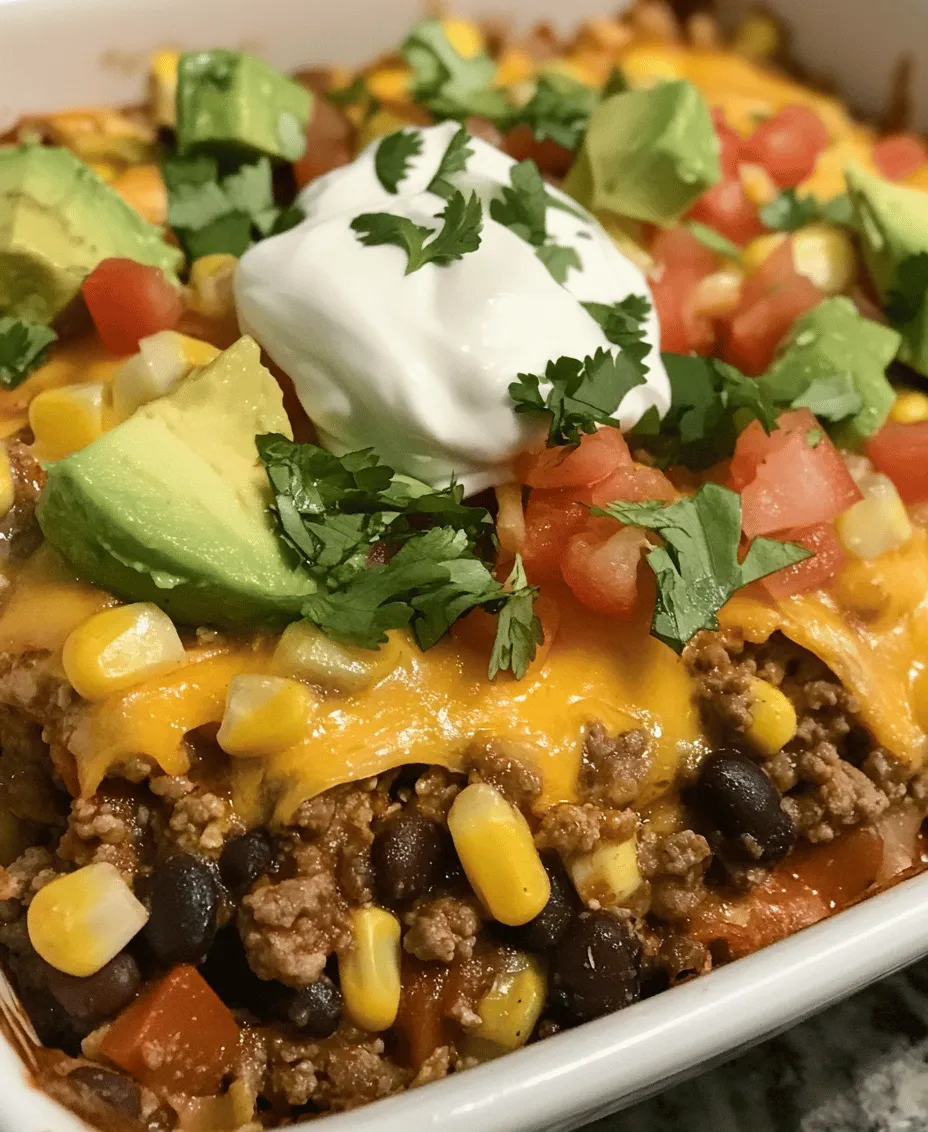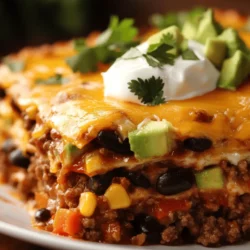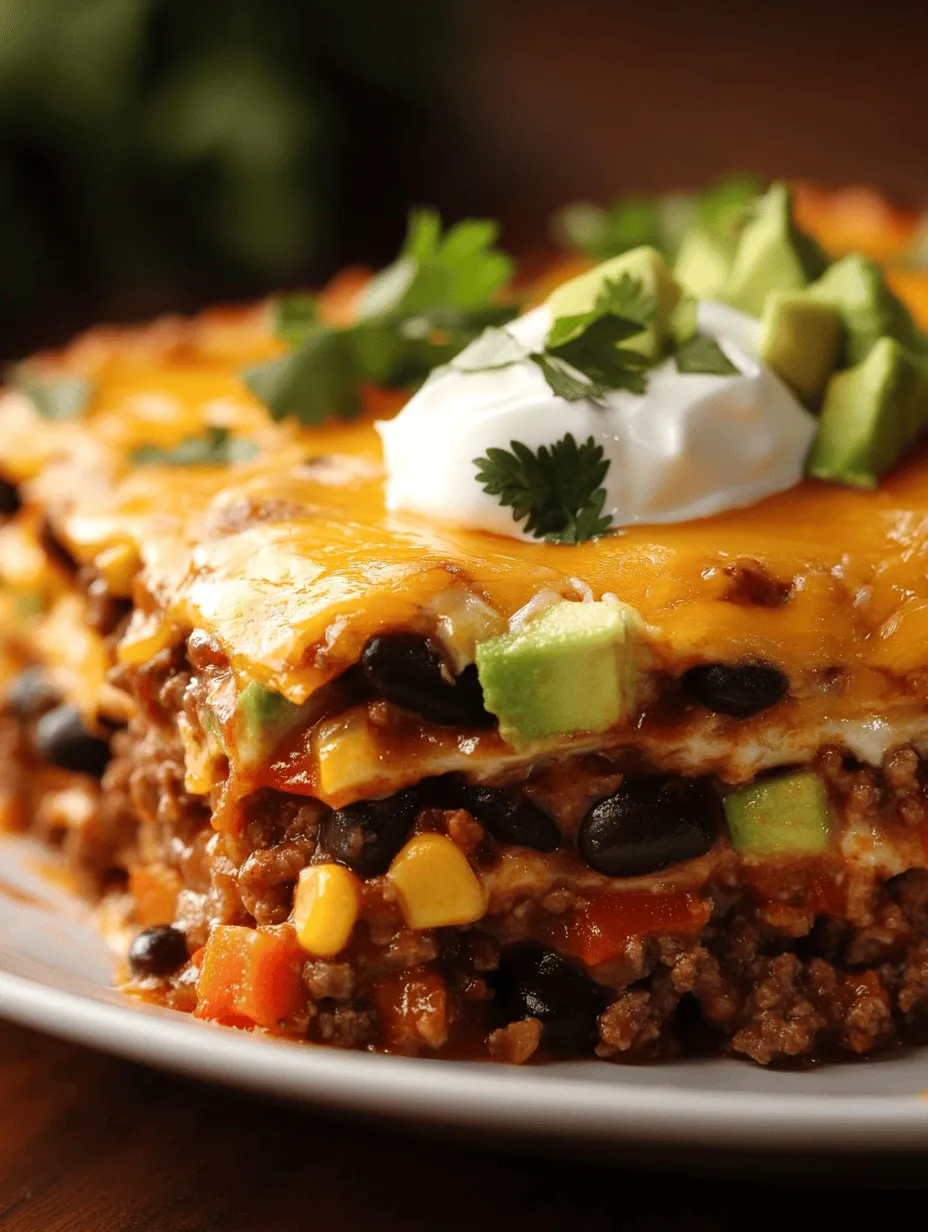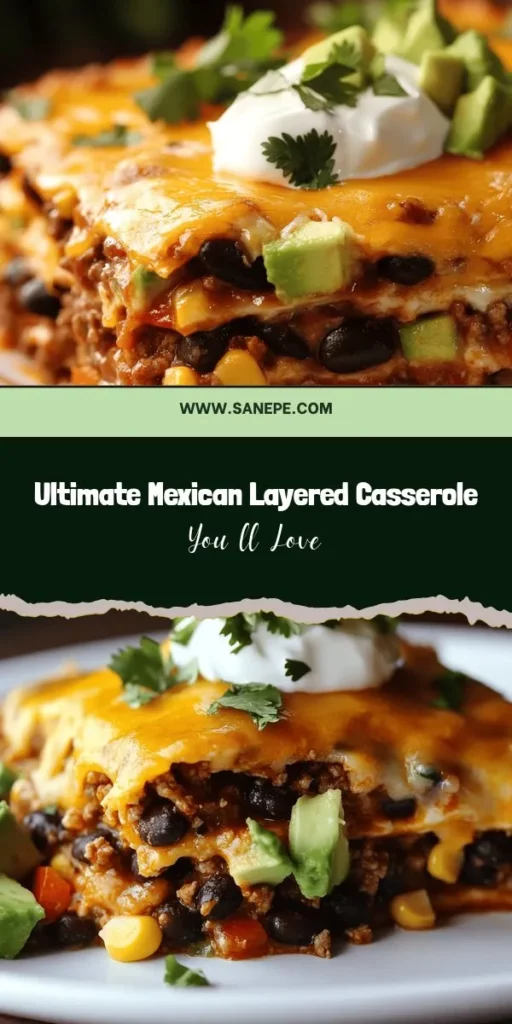Introduction
The Mexican Layered Casserole is a vibrant and flavorful dish that embodies the heart and soul of Mexican cuisine. This comforting casserole is a delightful fusion of ingredients that come together to create a satisfying meal perfect for family dinners or casual gatherings with friends. Its popularity stems from the ease of preparation, the ability to feed a crowd, and the tantalizing flavors that burst forth with every bite. Imagine layers of seasoned meat, fresh vegetables, and melted cheese, all harmoniously mingling in a warm, cheesy embrace—this dish is sure to be a hit.
The beauty of the Mexican Layered Casserole lies not only in its taste but also in its versatility. You can customize it to suit personal preferences or dietary needs, whether you prefer ground beef, turkey, or even a vegetarian alternative. This dish is a celebration of flavors, showcasing the best of what Mexican cooking has to offer while being simple enough to whip up on a busy weeknight. With just a few ingredients and some straightforward steps, you can create a home-cooked meal that rivals any restaurant.
In this article, we will explore the essential ingredients that make up this beloved casserole, as well as the preparation steps that will guide you through creating a delicious Mexican Layered Casserole in your own kitchen.
Understanding the Ingredients
To create a truly delectable Mexican Layered Casserole, it’s important to understand the key ingredients that contribute to its rich flavor and satisfying texture. Here, we will delve into each component, highlighting its role and the benefits it brings to the dish.
Ground Beef or Turkey
The choice of protein is crucial in shaping the flavor profile of your casserole. Ground beef is a classic choice, providing a robust and savory base that pairs beautifully with the other ingredients. It is rich in protein, iron, and essential vitamins, making it a nourishing option for a hearty meal. Alternatively, ground turkey offers a leaner option with lower fat content while still delivering ample protein. Whichever option you choose, browning the meat properly is key to unlocking its rich flavors. The Maillard reaction that occurs during browning enhances the overall taste of the casserole, creating a delicious depth that will shine through in every layer.
Vegetables
Fresh vegetables are the backbone of the Mexican Layered Casserole, providing not only flavor but also texture and color. Onions and garlic are essential for building a flavorful base; their aromatic qualities elevate the dish and create a savory foundation. Bell peppers add a touch of sweetness and crunch, while also contributing a vibrant pop of color. Using fresh produce is important, as it enhances the overall flavor and nutritional value of the casserole. Feel free to experiment with other vegetables, such as zucchini or corn, to create your own unique twist on this classic dish.
Legumes and Grains
Legumes and grains play a significant role in adding substance and nutritional value to the casserole. Black beans are a fantastic addition, providing protein, fiber, and a hearty texture that complements the meat. They also contribute a rich, earthy flavor that pairs beautifully with the spices used in the dish. Corn is another staple ingredient, offering sweetness and a delightful crunch. The use of corn tortillas as the base layer is particularly important; they not only add flavor but also help to absorb the juices from the other ingredients, keeping the casserole moist and flavorful.
Seasoning
No Mexican dish would be complete without the right seasoning. Taco seasoning is the star of the show in this casserole, infusing it with the unmistakable flavors of cumin, chili powder, and paprika. This blend of spices enhances the overall taste and authenticity of the dish, transporting your taste buds straight to Mexico. You can easily make your own taco seasoning blend at home, allowing you to adjust the spices to your liking. The seasoning should be generously mixed with the meat and vegetables, ensuring that every bite is packed with flavor.
Cheese and Cream
To finish off the layers, cheese and cream bring a rich, creamy texture that elevates the casserole to new heights. Cheddar cheese is a popular choice, melting beautifully and adding a sharp flavor that complements the other ingredients. Sour cream can also be included, dolloped on top or mixed in with the other components, providing a tangy contrast to the richness of the cheese. This creamy layer is what makes the casserole indulgent and comforting, inviting everyone to dig in and enjoy.
Preparation Steps for the Perfect Casserole
With a clear understanding of the ingredients, we can now delve into the preparation steps that will guide you in creating the perfect Mexican Layered Casserole. Each step is designed to ensure that your casserole is bursting with flavor and has the ideal texture.
Preheating the Oven
Before you start cooking, it’s essential to preheat your oven to around 375°F (190°C). Preheating the oven ensures that your casserole cooks evenly and thoroughly. When the oven is preheated, the cooking process begins immediately once you place your casserole inside, allowing for better texture and flavor development.
Cooking the Meat
Start by heating a large skillet over medium heat. Once hot, add your chosen ground meat—either beef or turkey. As the meat cooks, use a spatula to break it apart into smaller pieces. Browning the meat is crucial; it not only enhances its flavor through caramelization but also helps render some of the fat, adding richness to the dish. Cook until the meat is fully browned and no longer pink, which typically takes about 7-10 minutes. Drain any excess fat before moving on to the next step, as too much grease can make the casserole overly greasy.
Sautéing Vegetables
In the same skillet, add diced onions, minced garlic, and chopped bell peppers. Sautéing these ingredients brings out their natural sweetness and aroma, creating a flavorful base for your casserole. Cook the vegetables until they are softened and translucent, about 5-7 minutes. The goal is to achieve a delicate balance of flavors, so make sure not to overcook them. A well-sautéed mixture will provide a delectable contrast to the hearty meat and other layers.
Mixing Ingredients
Once the meat and vegetables are cooked, it’s time to blend all the flavors together. Return the browned meat to the skillet with the sautéed vegetables and add in your black beans, corn, and taco seasoning. Stir everything together to ensure that the seasoning is evenly distributed. Allow the mixture to simmer for about 5 minutes; this step is important as it allows the flavors to meld together, creating a harmonious filling for your casserole. The simmering process also helps the beans and corn absorb the spices, enhancing their taste.
Layering Technique
Now comes the fun part—layering your casserole! In a baking dish, start by placing a layer of corn tortillas at the bottom. This will serve as the foundation for your dish, absorbing the juices and flavors above. Follow this with a layer of the meat and vegetable mixture, spreading it evenly across the tortillas. Next, sprinkle a generous amount of shredded cheddar cheese on top. Repeat the layers, alternating between tortillas, filling, and cheese, until all ingredients are used up. Aim for at least three layers to ensure a well-balanced casserole. Finish with a final layer of cheese on top to achieve that mouthwatering golden crust when baked.
By carefully following these steps and understanding the role of each ingredient, you will be well on your way to creating a delicious Mexican Layered Casserole that is sure to impress. Stay tuned for the next part of this article, where we will discuss the final baking process and share some tips for achieving the perfect casserole every time.

Mexican Layered Casserole: A Culinary Delight
To create a truly memorable Mexican Layered Casserole, it’s essential to focus on the intricate layering process, baking techniques, garnishing, and nutritional benefits. Each step contributes to the overall flavor, presentation, and enjoyment of this crowd-pleaser.
Base Layers: The Significance of Starting with Salsa and Tortillas
The foundation of your Mexican Layered Casserole begins with two primary components: salsa and tortillas. Starting with a layer of salsa not only adds a burst of flavor but also provides moisture to the dish, ensuring that the tortillas do not dry out during baking. This initial layer creates a flavorful base that enhances every subsequent layer.
When selecting tortillas, consider using corn tortillas for an authentic taste. Their slightly firm texture holds up well under the weight of the other ingredients, ensuring that each bite is a delightful mix of flavors and textures. When layering, it’s crucial to overlap the tortillas slightly, creating a solid foundation that will support the fillings above.
Filling Distribution: Tips on Ensuring Even Coverage
Even coverage of the meat mixture and cheese is vital for a balanced flavor profile in the casserole. Begin by preparing your meat mixture, which typically includes seasoned ground beef, black beans, and diced vegetables. Once your filling is ready, use a spatula to spread an even layer over the tortillas.
To ensure that each serving contains a delightful combination of ingredients, avoid heaping the filling in one spot. Instead, distribute it generously across the layer, paying attention to the corners and edges. A tip for maintaining evenness is to work in sections: start at the center and gradually spread outward. This method helps to guarantee that every slice of the casserole is packed with flavor.
As you layer the cheese, opt for a blend of shredded cheeses such as cheddar and Monterey Jack. This combination not only adds depth of flavor but also creates the gooey, melty texture that elevates the dish. Sprinkle the cheese evenly over the filling, ensuring that it seeps down into the nooks and crannies created by the tortillas and filling.
Final Touches: The Role of Sour Cream and Cheese
The last layer of your casserole is where the magic happens. Adding a generous dollop of sour cream to the top layer before the final sprinkle of cheese gives the dish a creamy richness that complements the bold flavors beneath. As it bakes, the sour cream mingles with the cheese, creating a luscious topping that is irresistible.
For the final sprinkle of cheese, consider using a little extra to achieve a beautifully browned top. This not only ensures that each portion is cheesy but also enhances the visual appeal of the dish, making it an inviting centerpiece for any meal.
Baking the Casserole
Covering and Uncovering: The Purpose of Each Phase
Baking is a crucial step in bringing your Mexican Layered Casserole to life. Begin by covering the casserole with aluminum foil. This initial covering phase helps to trap steam, allowing the ingredients to meld together while preventing the cheese from burning too soon. The steam also helps cook the tortillas, softening them and ensuring they absorb all the delicious flavors from the filling.
After about 25-30 minutes of baking, carefully remove the foil. This step is critical for achieving that perfect golden-brown cheese topping. Allow the casserole to bake uncovered for an additional 10-15 minutes, or until the cheese is bubbling and has achieved a lovely golden hue.
Baking Time: Variations Based on Oven Types
Baking times can vary significantly depending on your oven type and personal preferences for cheese doneness. Conventional ovens may require different times compared to convection ovens, which tend to cook more evenly and efficiently. Keep an eye on the casserole during the final minutes, watching for the cheese to bubble and turn golden.
To check for doneness, insert a knife or toothpick into the center of the casserole. If it comes out hot and the cheese is melted, your dish is ready. Allow the casserole to cool for a few minutes before serving, as this will help it set, making it easier to cut into neat portions.
Garnishing and Serving
Fresh Ingredients: Adding Color and Flavor
Once your Mexican Layered Casserole is out of the oven, it’s time to think about garnishing. Fresh ingredients like chopped cilantro and diced avocado not only add color but also provide a refreshing contrast to the rich flavors of the casserole. Cilantro brings a bright, herbaceous note that complements the spicy elements, while avocado contributes creaminess and a subtle flavor.
For an extra crunch, consider adding sliced radishes or a sprinkle of diced tomatoes. These toppings enhance the visual appeal of your dish and make every bite exciting.
Serving Suggestions: Complementary Dishes
Pairing your casserole with complementary side dishes can elevate the meal. A simple green salad with a light vinaigrette offers a refreshing balance to the richness of the casserole. Alternatively, serve it alongside Mexican-style rice, which can absorb the flavors from the casserole while adding a carb element to the meal.
Tortilla chips are another excellent accompaniment, perfect for scooping up portions of the casserole. Consider serving them with a side of guacamole or salsa for an added layer of flavor.
Nutritional Information
Caloric Breakdown: Understanding Portion Sizes
When it comes to enjoying your Mexican Layered Casserole, understanding the caloric content can help you enjoy it mindfully. A typical serving of this casserole, which is approximately one-sixth of the recipe, contains around 400-500 calories. This can vary based on the specific ingredients used, such as the type of meat or the amount of cheese.
Health Benefits of Ingredients
The ingredients in the Mexican Layered Casserole offer various nutritional benefits. Lean meats, such as ground turkey or chicken, provide high-quality protein essential for muscle repair and growth. Black beans are a fantastic source of fiber, which aids digestion and helps maintain stable blood sugar levels.
Incorporating fresh vegetables not only boosts the flavor but also adds vital vitamins and minerals. Ingredients like bell peppers and onions contribute antioxidants that support overall health.
Conclusion
The Mexican Layered Casserole is more than just a meal; it’s an experience filled with the vibrant flavors and textures of Mexican cuisine. As you layer your ingredients, bake to perfection, and garnish with fresh herbs, you create a dish that is sure to impress family and friends alike. Its versatility makes it suitable for various occasions, from casual weeknight dinners to festive gatherings.
Embrace this recipe as a staple in your meal rotation, celebrating the bold flavors and hearty components that define Mexican cooking. With each bite, you’ll find comfort in the familiar tastes and the joy of sharing a delicious meal with those you love. Enjoy the delightful journey of preparing and savoring this remarkable dish!


